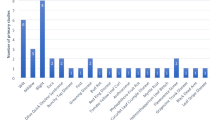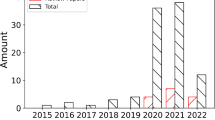Abstract
Aims and background
Pests and diseases of plants often threaten the availability and safety of plants for human consumption. To face these challenges, a new agricultural revolution is underway (agriculture 4.0). This agrarian revolution dramatically benefits from new digital technologies and artificial intelligence (AI).
Methods
The farmers need a reliable tool for an early disease diagnosis. Imaging is a promising technique for diagnosing and quantifying the disease plot. Easily automated and non-intrusive, imaging allows, with low costs in instrumentation and human resources, to account for much agricultural priority’s local mics on large production areas. The main purpose paper is to develop a hybrid model for tomato disease detection based on image data collection. We apply transfer learning and fine-tuning strategies to improve the performance of different pre-trained models. Two models have been selected to develop our hybrid model for plant disease identification among these CNN models. We used the plant village dataset, which contains nine classes of tomato diseases.
Results
First, we evaluate the performance of seven different architectures including VGG16, ResNet50, EfficientNetB0, EfficientNetB1, EfficientNetB2, EfficientNetB3 and EfficientNetB4. We applied the transfer learning technique. Then, the best two pre-trained models were selected and used to implement a weighted average ensemble. The proposed model achieves an accuracy of 0.981.
Conclusion
Many diseases can affect tomato plants and cause yield losses. Therefore, plant pathogens should be given more importance. Furthermore, this study can be adapted to cover other types of crops in future research.





Similar content being viewed by others
Data availability
Data is available from its original source as cited in the article. The PlantVillage dataset is available at https://www.kaggle.com/datasets/charuchaudhry/plantvillage-tomato-leaf-dataset
Abbreviations
- AI:
-
Artificial intelligence
- ML:
-
Machine learning
- SVM:
-
Support vector machines
- LR:
-
Logistic Regressions,
- KNN:
-
K-Nearest Neighbors
- DT:
-
Decision Trees
- RF:
-
Random forest
- NB:
-
Naive Bayes
- LDA:
-
Linear discriminant analysis
- HOG:
-
Histogram of oriented gradients
- PLS:
-
Partial least squares
- ANN:
-
Artificial neural network
- CNN:
-
Convolutional neural network
- VGG-16:
-
Visual geometry group-16
- TP:
-
True Positive
- TN:
-
True Negative
- FN:
-
False Negative
- FP:
-
False Positive
- TinyML:
-
Tiny machine learning
References
Albattah W, Nawaz M, Javed A, Masood M, Albahli S (2022) A novel deep learning method for detection and classification of plant diseases. Complex Intell Syst 8:507–524. https://doi.org/10.1007/s40747-021-00536-1
Anjna, Singh (2020) Hybrid system for detection and classification of plant disease using qualitative texture features analysis. Proc Comput Sci 167:1056–1065. https://doi.org/10.1016/j.procs.2020.03.404
Ayan E, Erbay H, Varçın F (2020) Crop pest classification with a genetic algorithm-based weighted ensemble of deep convolutional neural networks. Comput Electron Agric 179:105809. https://doi.org/10.1016/j.compag.2020.105809
Bedi P, Gole P (2021) Plant disease detection using hybrid model based on convolutional autoencoder and convolutional neural network. Artif Intell Agric 5:90–101. https://doi.org/10.1016/j.aiia.2021.05.00
Brahimi M, Boukhalfa K, Moussaoui A (2017) Deep learning for tomato diseases: classification and symptoms visualization. Appl Artif Intell 31:299–315. https://doi.org/10.1080/08839514.2017.1315516
Chehri A, Chaibi H, Saadane R, Hakem N, Wahbi M (2020) A Framework of Optimizing the Deployment of IoT for Precision Agriculture Industry. Proc Comput Sci 176:2414–2422
Chen J, Chen J, Zhang D, Sun Y, Nanehkaran YA (2020) Using deep transfer learning for image-based plant disease identification. Comput Electron Agric 173:105393. https://doi.org/10.1016/j.compag.2020.105393
Ciresan DC, Meier U, Gambardella LM, Schmidhuber J (2010) Deep big simple neural nets excel on handwritten digit recognition. Neural Comput 22:3207–3220. https://doi.org/10.1162/NECO_a_00052
Deng J, Dong W, Socher R, Li LJ, Li K, Fei-Fei L (2009) Imagenet: A large-scale hierarchical image database. In 2009 IEEE conference on computer vision and pattern recognition (pp. 248–255). Ieee (2021)
Durga NK, Anuradha G (2019) Plant disease identification using SVM and ANN Algorithms. 7:3
Durmuş H, Güneş EO, Kırcı M (2017) Disease detection on the leaves of the tomato plants by using deep learning. In 2017 6th International Conference on Agro-Geoinformatics, pp. 1–5
Ferentinos KP (2018) Deep learning models for plant disease detection and diagnosis. Comput Electron Agric 145:311–318. https://doi.org/10.1016/j.compag.2018.01.009
Geetharamani G, Pandian A (2019) Identification of plant leaf diseases using a nine-layer deep convolutional neural network. Comput Electr Eng 76:323–338
Gonçalves CB, Souza JR, Fernandes H (2022) CNN architecture optimization using bio-inspired algorithms for breast cancer detection in infrared images. Comput Biol Med 142:105205. https://doi.org/10.1016/j.compbiomed.2021.105205
He K, Zhang X, Ren S, Sun J (2016) Deep residual learning for image recognition. 2016 IEEE Conference on Computer Vision and Pattern Recognition (CVPR)
Hemming J, Rath T (2001) PA—Precision Agriculture. J Agric Eng Res 78:233–243. https://doi.org/10.1006/jaer.2000.0639
Holland J (1992) Genetic algorithms. Sci Am 1(267):66–72
Javanmardi S, Miraei Ashtiani S-H, Verbeek FJ, Martynenko A (2021) Computer-vision classification of corn seed varieties using deep convolutional neural network. J Stored Prod Res 92:101800. https://doi.org/10.1016/j.jspr.2021.101800
Jin S, Su Y, Gao S, Wu F, Hu T, Liu J, Li W, Wang D, Chen S, Jiang Y, Pang S, Guo Q (2018) Deep learning: individual maize segmentation from terrestrial lidar data using faster R-CNN and regional growth algorithms. Front Plant Sci 9:866. https://doi.org/10.3389/fpls.2018.00866
Johannes A, Picon A, Alvarez-Gila A, Echazarra J, Rodriguez-Vaamonde S, Navajas AD, Ortiz-Barredo A (2017) Automatic plant disease diagnosis using mobile capture devices, applied on a wheat use case. Comput Electron Agric 138:200–209. https://doi.org/10.1016/j.compag.2017.04.013
Kamilaris A, Prenafeta-Boldú F (2018) Deep learning in agriculture: A survey. Comput Electron Agric 147:70–90
Kaya A, Keceli A, Catal C, Yalic H, Temucin H, Tekinerdogan B (2019) Analysis of transfer learning for deep neural network-based plant classification models. Comput Electron Agric 158:20–29
Kilicarslan S, Celik M, Sahin Ş (2021) Hybrid models based on genetic algorithm and deep learning algorithms for nutritional Anemia disease classification. Biomed Signal Process Control 63:102231. https://doi.org/10.1016/j.bspc.2020.102231
Kim Y, Evans R, Iversen W (2008) Remote sensing and control of an irrigation system using a distributed wireless sensor network. IEEE Trans Instrum Meas 7(57):1379–1387. https://doi.org/10.1109/tim.2008.917198
LeCun Y, Boser B, Denker J, Henderson D, Howard R, Hubbard W, Jackel L (1989) Backpropagation applied to handwritten zip code recognition. Neural Comput 4(1):541–551
LeCun Y, Bengio Y, Hinton G (2015) Deep learning. Nature 7553(521):436–444
Liu J, Wang X (2020) Early recognition of tomato gray leaf spot disease based on MobileNetv2-YOLOv3 model. Plant Methods 16:83. https://doi.org/10.1186/s13007-020-00624-2
Mohanty SP, Hughes DP, Salathé M (2016) Using deep learning for image-based plant disease detection. Front Plant Sci 7:1419. https://doi.org/10.3389/fpls.2016.01419
Mokhtar U, Ali MAS, Hassanien AE, Hefny H (2015) Identifying Two of Tomatoes Leaf Viruses Using Support Vector Machine. In: Mandal JK, Satapathy SC, Kumar Sanyal M, Sarkar PP, Mukhopadhyay A (eds) Information Systems Design and Intelligent Applications. Springer India, New Delhi, pp 771–782
Ouafiq EM, Saadane R, Chehri A (2022) Data Management and Integration of Low Power Consumption Embedded Devices IoT for Transforming Smart Agriculture into Actionable Knowledge. Agriculture 12:329. https://doi.org/10.3390/agriculture12030329
Padol PB, Yadav AA (2016) SVM classifier based grape leaf disease detection, 2016 Conference on Advances in Signal Processing (CASP)
Pérez E, Ventura S (2021) An ensemble-based convolutional neural network model powered by a genetic algorithm for melanoma diagnosis. Neural Comput
Rumpf T, Mahlein A, Steiner U, Oerke E, Dehne H, Plümer L (2010) Early detection and classification of plant diseases with Support Vector Machines based on hyperspectral reflectance. Comput Electron Agric 1(74):91–99
Saeed F, Khan MA, Sharif M, Mittal M, Goyal LM, Roy S (2021) Deep neural network features fusion and selection based on PLS regression with an application for crops diseases classification. Appl Soft Comput 103:107164
Selvaraj MG, Vergara A, Ruiz H, Safari N, Elayabalan S, Ocimati W, Blomme G (2019) AI-powered banana diseases and pest detection. Plant Methods 15:92. https://doi.org/10.1186/s13007-019-0475-z
Simonyan K, Zisserman A (2015) Very deep convolutional networks for large-scale image recognition. ArXiv14091556 Cs
Slalmi A, Chaibi H, Saadane R, Chehri A, Jeon G, Aroussi HK (2021) Energy-efficient and self-organizing Internet of Things networks for soil monitoring in smart farming. Comput Electr Eng 92
Szegedy C, Liu W, Jia Y, Sermanet P, Reed S, Anguelov D, Erhan D, Vanhoucke V, Rabinovich A (2014) Going deeper with convolutions. ArXiv14094842 Cs
Tan M, Le Q (2019) Efficientnet: Rethinking model scaling for convolutional neural networks. In International Conference on Machine Learning, pp 6105–6114
Tarek H, Aly H, Eisa S, Abul-Soud M (2022) Optimized deep learning algorithms for tomato leaf disease detection with hardware deployment. Electronics 11:140. https://doi.org/10.3390/electronics11010140
Too EC, Yujian L, Njuki S, Yingchun L (2019) A comparative study of fine-tuning deep learning models for plant disease identification. Comput Electron Agric 161:272–279. https://doi.org/10.1016/j.compag.2018.03.032
Trivedi NK, Gautam V, Anand A, Aljahdali HM, Villar SG, Anand D, Goyal N, Kadry S (2021) Early detection and classification of tomato leaf disease using high-performance deep neural network. Sensors 21(23):7987. https://doi.org/10.3390/s21237987
Tuncer A (2021) Cost-optimized hybrid convolutional neural networks for detection of plant leaf diseases. J Ambient Intell Humaniz Comput 12:8625–8636
Wang G, Sun Y, Wang J (2017) Automatic Image-Based Plant Disease Severity Estimation Using Deep Learning. Comput Intell Neurosci 2017:1–8. https://doi.org/10.1155/2017/2917536
Wang Y, Wang H, Peng Z (2021) Rice diseases detection and classification using attention based neural network and bayesian optimization. Expert Syst Appl 178:114770. https://doi.org/10.1016/j.eswa.2021.114770
Weiss S, Van Treuren W, Lozupone C, Faust K, Friedman J, Deng Y, Xia LC, Xu ZZ, Ursell L, Alm EJ, Birmingham A, Cram JA, Fuhrman JA, Raes J, Sun F, Zhou J, Knight R (2016) Correlation detection strategies in microbial data sets vary widely in sensitivity and precision. ISME J 10:1669–1681. https://doi.org/10.1038/ismej.2015.235
Whitley D (1994) A genetic algorithm tutorial. Stat Comput 2(4):65–85
Wood L (2020) Artificial Intelligence in agriculture market. Report, pp 40–153. https://www.marketsandmarkets.com/Market-Reports/ai-in-agriculture-market-159957009.html
Yu Y, Zhang M (2021) Control chart recognition based on the parallel model of CNN and LSTM with GA optimization. Expert Syst Appl 185:115689
Zhang K, Wu Q, Liu A, Meng X (2018) Can deep learning identify tomato leaf disease? Advances in Multimedia, pp. 1–10
Funding
The authors declare that no funds, grants, or other support were received during the preparation of this manuscript.
Author information
Authors and Affiliations
Contributions
M.M participated in the study's experimental design and grazing experiment; M.M, H.C, R.S and A. C performed the statistical analysis. M.M and H. C, R. S, A. C, and A. E-R completed the methodology, the validation, formal analysis, and investigation. M. M prepared the draft for the manuscript. The editing was completed by A. C, and G. J. All authors read and approved the final manuscript.
Corresponding author
Ethics declarations
Competing interests
The authors declare that they have no actual or potential competing financial interests.
Additional information
Responsible Editor: Muhammad Tariq.
Publisher's note
Springer Nature remains neutral with regard to jurisdictional claims in published maps and institutional affiliations.
Rights and permissions
About this article
Cite this article
Moussafir, M., Chaibi, H., Saadane, R. et al. Design of efficient techniques for tomato leaf disease detection using genetic algorithm-based and deep neural networks. Plant Soil 479, 251–266 (2022). https://doi.org/10.1007/s11104-022-05513-2
Received:
Accepted:
Published:
Issue Date:
DOI: https://doi.org/10.1007/s11104-022-05513-2




